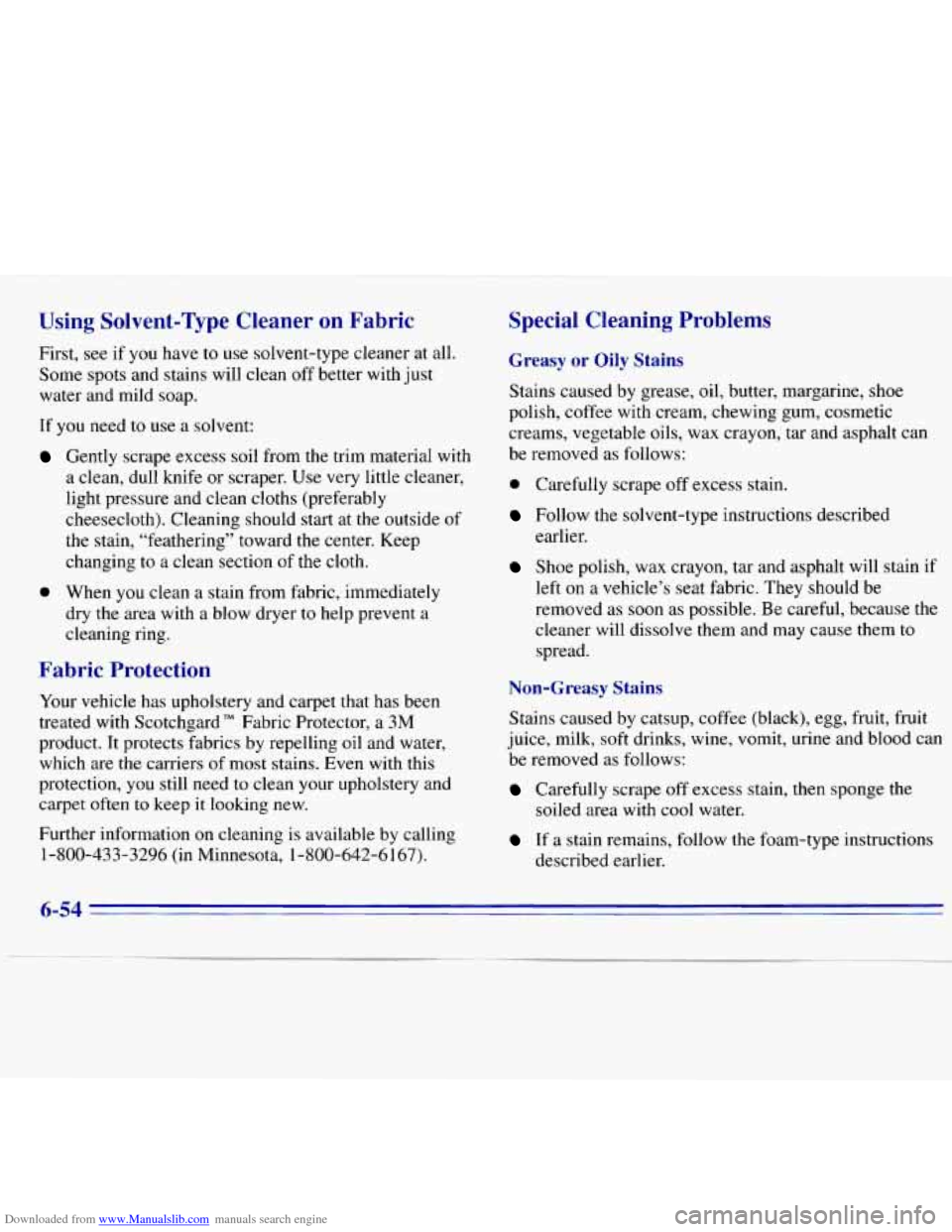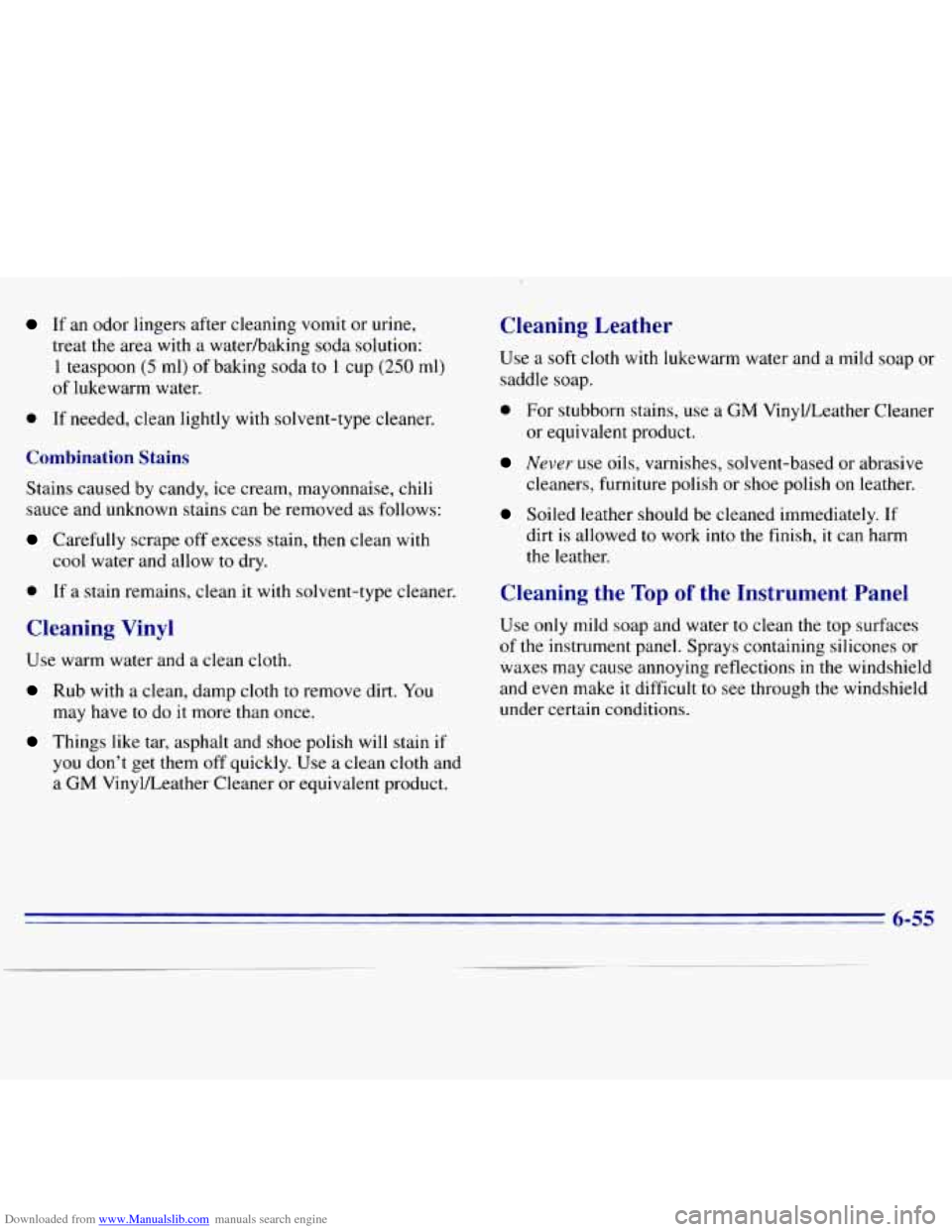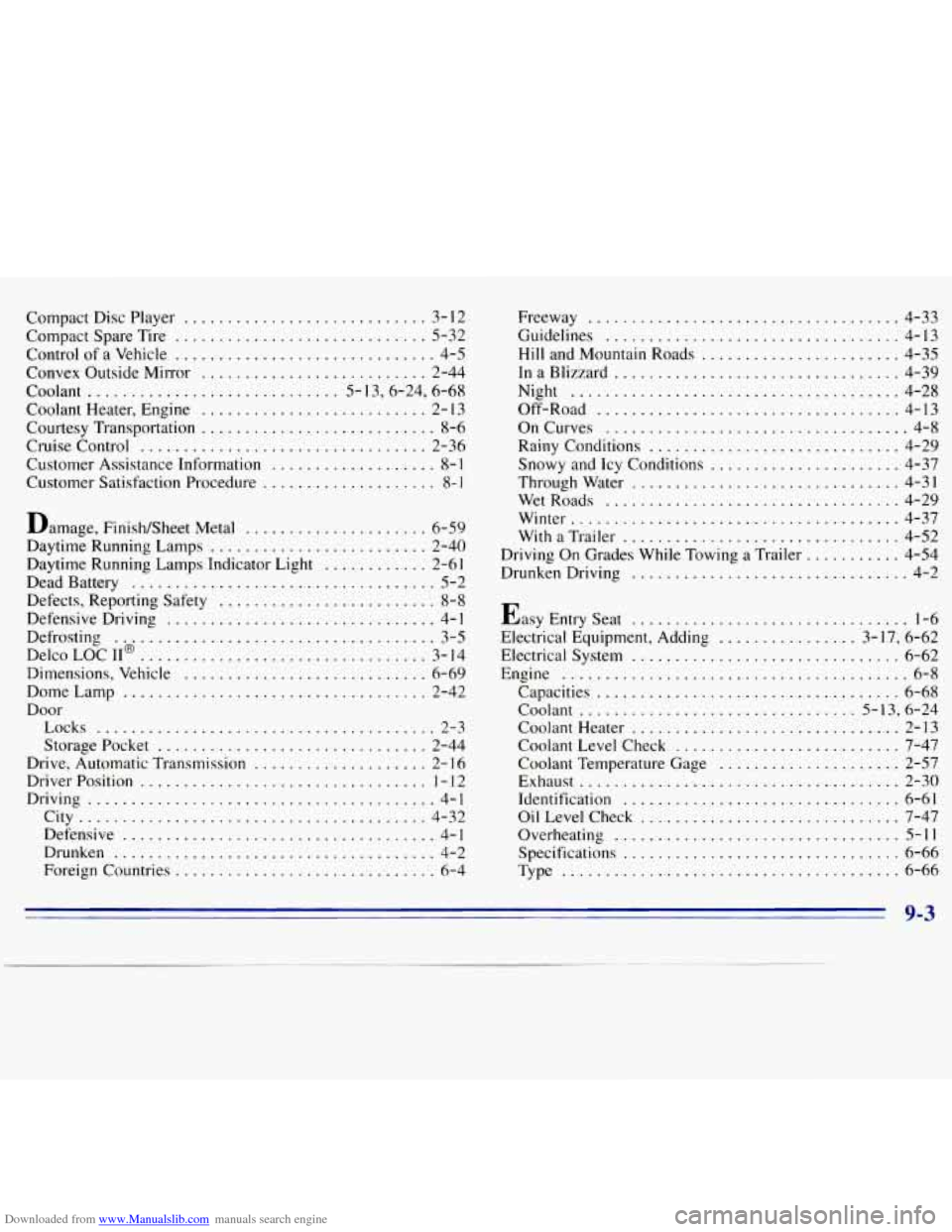1996 CHEVROLET S10 oil type
[x] Cancel search: oil typePage 131 of 375

Downloaded from www.Manualslib.com manuals search engine Care of Your Cassette Tape Player
A tape player that is not cleaned regularly can cause
reduced sound quality, ruined cassettes or a damaged
mechanism. Cassette tapes should be stored
in their
cases away from contaminants, direct sunlight and
extreme heat. If they aren’t, they may not operate
properly or may cause failure of the tape player.
Your tape player should be cleaned regularly after every
50 hours of use. If you notice a reduction in sound
quality, try
a known good cassette to see if the tape or
the tape player is at fault. If this other cassette has no
improvement in sound quality, clean the tape player.
Cleaning may be done with a scrubbing action,
non-abrasive cleaning cassette with pads which scrub
the tape head as the hubs of
the cleaner cassette turn. It
is normal for the cassette
to eject while cleaning. Insert
the cassette at least three times
to ensure thorough
cleaning.
A scrubbing action cleaning cassette is
available through your
GM dealer.
You may also choose a non-scrubbing action, wet-type
cleaner which uses a cassette with a fabric belt to clean
the tape head. This type of cleaning cassette will not
eject. It may not clean as thoroughly as
the scrubbing
type cleaner. Cassettes are
subject to wear and the sound quality may
degrade over time. Always make sure that the cassette
tape is in good condition before you have your tape
player serviced.
Care of Your Compact Discs
Handle discs carefully. Store them in their original cases
or other protective cases and away from direct sunlight
and dust. If
the surface of a disc is soiled, dampen a
clean, soft cloth
in a mild, neutral detergent solution and
clean it, wiping from the center to the edge.
Be sure never to touch the signal surface when handling
discs. Pick up discs by grasping the outer edges or the
edge of the hole and the outer edge.
Fixed Mast Antenna
The fixed mast antenna can withstand most car washes
without being damaged. If the mast should ever become
slightly bent,
you can straighten it out by hand. If the
mast is badly bent, as
it might be by vandals, you should
replace
it.
Check every once in a while to be sure the mast is still
tightened to
the fender.
3-18
Page 280 of 375

Downloaded from www.Manualslib.com manuals search engine Using Solvent-Type Cleaner on Fabric
First, see if you have to use solvent-type cleaner at all.
Some spots and stains will clean off better with just
water and mild soap.
If
you need to use a solvent:
Gently scrape excess soil from the trim material with
a clean, dull knife or scraper. Use very little cleaner,
light pressure and clean cloths (preferably
cheesecloth). Cleaning should start at the outside of
the stain, “feathering” toward the center. Keep
changing to a clean section
of the cloth.
0 When you clean a stain from fabric, immediately
dry the area with a blow dryer to help prevent a
cleaning ring.
Fabric Protection
Your vehicle has upholstery and carpet that has been
treated with Scotchgard
TM Fabric Protector, a 3M
product. It protects fabrics by repelling oil and water,
which are the carriers
of most stains. Even with this
protection,
you still need to clean your upholstery and
carpet often
to keep it looking new.
Further information
on cleaning is available by calling
1-800-433-3296 (in Minnesota, 1-800-642-6 167).
Special Cleaning Problems
Greasy or Oily Stains
Stains caused by grease, oil, butter, margarine, shoe
polish, coffee with cream, chewing gum, cosmetic
creams, vegetable
oils, wax crayon, tar and asphalt can
be removed as follows:
0 Carefully scrape off excess stain.
Follow the solvent-type instructions described
earlier.
Shoe polish, wax crayon, tar and asphalt will stain if
left on a vehicle’s seat fabric. They should be
removed as soon as possible. Be careful, because the
cleaner will dissolve them and may cause them to
spread.
Non-Greasy Stains
Stains caused by catsup, coffee (black), egg, fruit, fruit
juice, milk, soft drinks, wine, vomit, urine and blood can
be removed as follows:
Carefully scrape off excess stain, then sponge the
soiled area with cool water.
If a stain remains, follow the foam-type instructions
described earlier.
6-54
Page 281 of 375

Downloaded from www.Manualslib.com manuals search engine If an odor lingers after cleaning vomit or urine,
treat the area with a waterhaking soda solution:
1 teaspoon (5 ml) of baking soda to 1 cup (250 ml)
of lukewarm water.
0 If needed, clean lightly with solvent-type cleaner.
Combination Stains
Stains caused by candy, ice cream, mayonnaise, chili
sauce and unknown stains can be removed as follows:
Carefully scrape off excess stain, then clean with
cool water and allow to dry.
0 If a stain remains, clean it with solvent-type cleaner.
Cleaning Vinyl
Use warm water and a clean cloth.
Rub with a clean, damp cloth to remove dirt. You
may have to do it more than once.
Cleaning Leather
Use a soft cloth with lukewarm water and a mild soap or
saddle soap.
0 For stubborn stains, use a GM VinylILeather Cleaner
or equivalent product.
Never use oils, varnishes, solvent-based or abrasive
cleaners, furniture polish or shoe polish
on leather.
Soiled leather should be cleaned immediately. If
dirt is allowed to work into the finish, it can harm
the leather.
Cleaning the Top of the Instrument Panel
Use only mild soap and water to clean the top surfaces
of the instrument panel. Sprays containing silicones or
waxes may cause annoying reflections in the windshield
and even make it difficult
to see through the windshield
under certain conditions.
Things like tar, asphalt and shoe polish will stain if
you don’t get them off quickly. Use a clean cloth and
a GM Vinylkeather Cleaner or equivalent product.
6-55
Page 367 of 375

Downloaded from www.Manualslib.com manuals search engine Compact Disc Player ............................ 3- I2
Compact Spare Tire ............................. 5-32
Control of
a Vehicle .............................. 4-5
Convex Outside Mirror
.......................... 2-44
Coolant
............................. 5- 13.6.24. 6.68
Coolant Heater. Engine .......................... 2- I3
Courtesy Transportation ........................... 8-6
Cruise Control ................................. 2-36
Customer Assistance Information
................... 8-1
Customer Satisfaction Procedure .................... 8- 1
Damage. Finish/Sheet Metal ..................... 6-59
Daytime Running Lamps ......................... 2-40
Daytime Running Lamps Indicator Light
............ 2-61
Dead Battery
................................... 5-2
Defects. Reporting Safety ......................... 8-8
Defensive Driving ............................... 4- I
Defrosting .................................... 3-5
Delco LOC 11' ................................. 3- 14
Dimensions. Vehicle
............................ 6-69
DomeLamp ................................... 2-42
Door Locks
....................................... 2-3
StoragePocket
............................... 2-44
Drive. Automatic Transmission
.................... 2- 16
DriverPosition ................................. 1-12
Driving
........................................ 4-1
City ........................................ 4-32
Defensive
.................................... 4-1
Drunken ..................................... 4-2
Foreign Countries
.............................. 6-4 Freeway
.................................... 4-33
Guidelines
.................................. 4-13
Hill and Mountain Roads
....................... 4-35
InaBlizzard
................................. 4-39
Night
...................................... 4-28
Off-Road
................................... 4-13
OnCurves
................................... 4-8
Rainy Conditions
............................. 4-29
Snowy and Icy Conditions
...................... 4-37
Throughwater
............................... 4-31
WetRoads
.................................. 4-29
Winter
...................................... 4-37
With
a Trailer ................................ 4-52
DrunkenDriving
................................ 4-2
Driving
On Grades While Towing
a Trailer ........... 4-54
Easy Entry Seat
................................ 1-6
Electrical Equipment. Adding ................ 3-1.7, 6-62
Electrical System
............................... 6-62
Capacities
................................... 6-68
Coolant ................................ 5- 13. 6-24
Coolant Heater ............................... 2-13
Coolant Level Check
.......................... 7-47
Coolant Temperature Gage
..................... 2-57
Exhaust
..................................... 2-30
Identification ................................ 6-61
OilLevelCheck
.............................. 7-47
Overheating
................................. 5-11
Specifications ................................ 6-66
Type ........................................ 6-66
Engine
........................................ 6-8
9-3